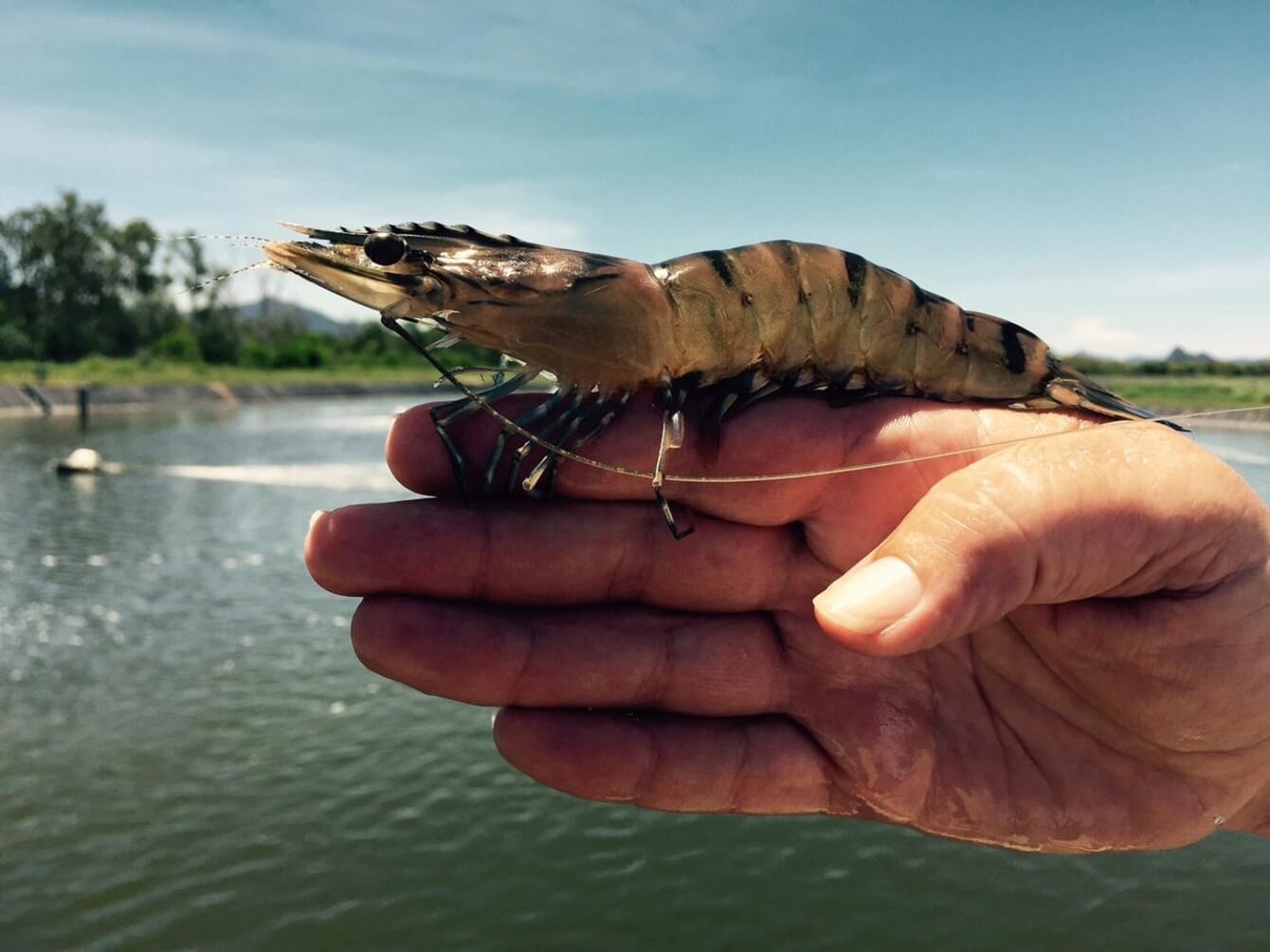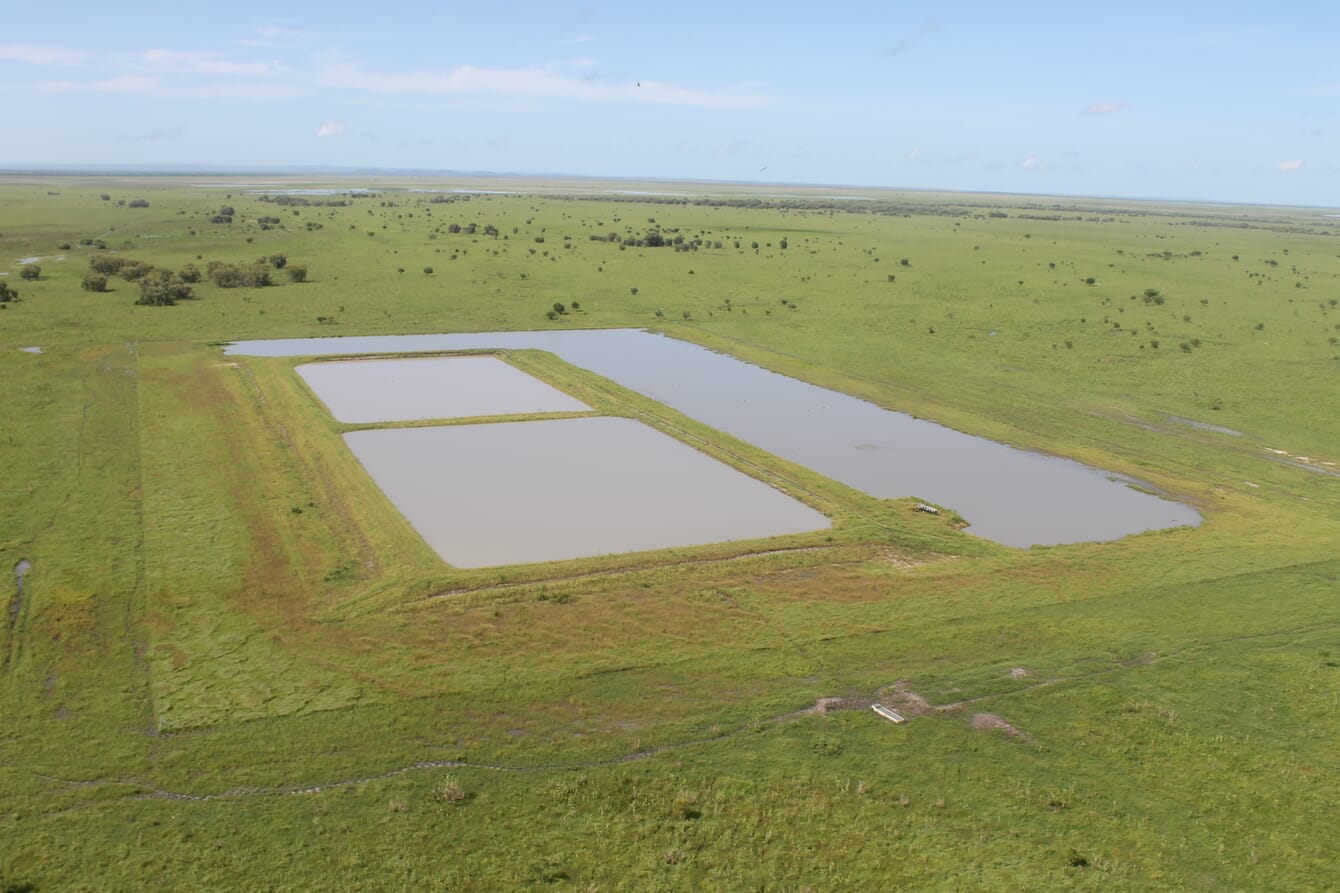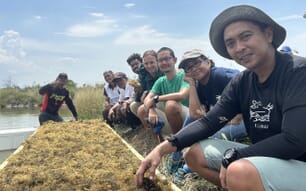
© Seafarms
Seafarms Group Limited’s newest aquaculture endeavour, Project Sea Dragon, is set to become Australia’s largest tiger prawn farming operation and one of the world’s largest prawn farms. The facility is projected to produce 150,000 tonnes of tiger prawns (Penaeus monodon) per annum when fully operational — approximately half of which will be exported overseas.
On 23 June Seafarms announced it had secured an AUD $92.5 million placement from shareholders to go towards funding Stage 1a of Project Sea Dragon, with eligible shareholders able to participate under a share purchase plan to raise a further $15 million for the venture.
After the coronavirus pandemic halted progress for several months — an agreement reached earlier this year with construction conglomerate Canstruct injected fresh momentum into the project. Building of phase one is now set to begin immediately at the Legune Station breeding centre, with the $78 million construction package involving the construction of 396 hectares of ponds at Legune Station in the Northern Territory. Canstruct will also be responsible for procurement, risk assessment and work packages management associated with this phase.
An economic game-changer for the region
Prawn and shrimp farms are typically located in Asia, where tropical conditions and relatively undeveloped infrastructure systems, combined with the intensification of the prawn farming industry, has led to higher density of stocking. In some cases this has resulted in eutrophication, disease outbreaks and vulnerability to changing climate conditions — contributing to increased likelihood of economic losses. By contrast, those behind Project Sea Dragon say it has the advantage of being located in Australia, where climate conditions are well suited and infrastructure is more highly developed.
With four project sites located across the Northern Territory (NT) and Western Australia (WA), the project ultimately aims to produce over 150,000 tonnes of black tiger prawn, year-round and aims to conduct its first harvest in the third quarter of 2023.
The Bynoe core breeding and broodstock maturation facility will produce the prawns to be delivered to the nursery and production grow-out ponds at Legune Station, with the Exmouth Founder Stock Centre in WA providing additional capacity for the project’s pathogen-free (SPF) domestication programme.
After eight years of research, planning and development, as well as over $120 million in investment — once completed the integrated land-based project will represent a major economic and environmental transformation for the remote region.
The federal government has expressed its support for Project Sea Dragon, highlighting the boost the project promises to bring to the NT and regional economy in WA. The project’s managing director, Chris Mitchell has asserted the project will become more valuable to the NT economy than the state’s entire live cattle trade. Seafarms Group hopes to produce robust prawns that will demand a premium price on the market, and create a year-round industry in the region that will support between 200 and 300 construction jobs and in excess of 150 jobs once the project is fully operational.
“In particular, many of the jobs in the north of Australia are seasonal and Project Sea Dragon will offer year-round employment. The project is in relatively remote parts of Australia, the project will diversify the local economy,” explains Dr Mitchell.
While the Northern Territory government has already contributed close to $50 million of taxpayer’s funds towards the project — primarily on two roads — NT Infrastructure Minister Eva Lawler has assured
this development would be useful to the state beyond the Seafarms project. The Western Australia government also spent $18 million on a road that would connect the Kimberley to the NT.

© Seafarms
Assessing complex socio-cultural impacts
According to Seafarms, one of the central aims of the project is to increase cultural, employment and business participation for Traditional Owners and Aboriginal people in its areas of operation. An Indigenous Land Use Agreement (ILUA), signed in 2017, involved Traditional Owners of lands at Legune Station agreeing to suspend their Native Title for a period of 95 years in exchange for an undisclosed value in compensation.
Northern Land Council CEO Joe Morrison has said the agreement involves a jobs package and a detailed plan to protect sacred sites. He also stated the project promises an opportunity for indigenous people to participate in the economic development trajectory of the Northern Territory.
Asked about the importance of this relationship, Seafarms’ Dr Mitchell iterated: “Project Sea Dragon is committed to supporting Aboriginal people to sustainably manage the Legune area.”
A Social Impact Assessment released by Seafarms in 2016 outlined potential impacts to indigenous heritage, relating to limitations on traditional use and potential damage to sites of importance if the project proceeded. Seafarms outlined a mitigation plan for these concerns which, in addition to the later-attained ILUA, also involved the attainment of clearance from the Aboriginal Areas Protection Authority (AAPA), the development of a Heritage Management Plan and Cultural Heritage Management Policy, and Traditional Owner Land Access Protocols.
According to the assessment, the Legune Station area is home to a number of sacred sites protected under the Aboriginal Sacred Sites Act in the NT. While acknowledging their presence, the assessment states that “large areas of Legune have not been subject to archaeological survey, and as such, the NT archaeological database may not record all Aboriginal sites and artefacts present in the area”.
“Some of the project infrastructure, including roads, quarries and an accommodation village will be situated on the Cockatoo land system, which has a very high likelihood of archaeological sites [that] may include rock art and artefact scatters.”
Commenting on Seafarm’s arrangement with Traditional Owners, Dr Mitchell asserts that: “Seafarms is working with the Northern Land Council (NLC) to plan for a ranger programme for the Legune area to be led by the NLC. Detailed planning includes defining the operating area for the ranger programme, the scope of activities, appropriate governance arrangements and infrastructure needs.”
Assessing environmental impacts and sustainability
Dr Mitchell is an environmental scientist who has previously worked with Australia’s national science agency (CSIRO) and headed CO2 Australia Limited, a carbon project development firm with specialisation in native revegetation and reforestation projects, such as the 20 Million Trees Programme. CO2 Australia managed the draft Environmental Impact Statement produced in 2016 for Phase One of Project Sea Dragon, which aims to produce 6,000 tonnes of prawns a year.
“Project Sea Dragon has been approved for its Stage 1 development based on two very comprehensive Environmental Impact Statements, with the one for the Legune site consisting of more than 10,000 pages of information. Seafarms intends to meet the highest standards in all aspects of sustainability: economic, social and environmental,” he states.
The statement includes an assessment of the project’s total projected greenhouse gas (GHG) emissions as well as those associated only with the projects’ construction (at the time projected to commence in 2017) and an estimated 25 year operating life. Importantly, the assessment is limited to Scope 1 emissions — meaning those released as a direct result of activities at the facility level. Therefore, these estimates exclude emissions that will be produced from associated activities generated within the wider economy, such as those associated with export and off-site transportation. However, in addition to Project Sea Dragon, Seafarms group holds separate subsidiary companies operating in the carbon and environmental offset spaces.
The total GHG emissions associated with the project are estimated to equal approximately 2,018,104 tonnes C02-e (carbon dioxide equivalent), the vast majority of which can be attributed to the combustion of diesel, a fuel refined from crude oil. The next largest contribution to emissions will be produced through land clearing — which comprises one of the agricultural sectors’ primary contributions to Australia’s total emissions.
The total average annual emissions associated with the project amount to 72,075 tonnes, a figure which makes up a relatively small percentage of the country’s total 2019 emissions (0.013 percent) and 0.34 percent of the Northern Territory’s total 2019 emissions. The amount does exceed the 25kt threshold listed in the Commonwealth National Greenhouse and Energy Reporting Act 2007 and will thus legally require Seafarms to report its emissions annually.
While Australia’s carbon footprint is the highest per capita among top emitting countries, as a signatory to the Paris Agreement, Australia has legally committed to reducing its carbon emissions below 2005 levels by 26-28 percent by 2030 to ensure global warming is restricted to 2°C. The latest quarterly emissions report, published by emissions tracking organisation Ndevr Environmental, shows that at current trajectories, these emissions targets will not be achieved, and if trends continue Australia will have emitted over 304 million tonnes of CO2 equivalent more than the Paris emissions reductions targets by 2030.
A 2018 aquaculture viability report produced by the CSIRO and commissioned by the Australian government Department of Infrastructure, Regional Development and Cities highlights Australia’s position as a global leader in prawn farming sustainability, while pointing out constraints on expansion faced by the industry due to regulations relating to the proximity of the Great Barrier Reef. It outlines how these regulatory complications played a role in Seafarms’ move to establish operations in the Northern Territory and Western Australia.

© Michael Theis
Despite the move affording the project relative regulatory freedoms, the Legune coastal floodplain is a site identified by the Northern Territory Government as one of conservation significance, due to its high concentration of waterbird and shorebird species. In the wet season, the water from the catchment is flushed into the estuarine receiving environment, and this run-off transports freshwater, sediment loads and detritus that have built up during the dry season and contain nutrients that are deposited downstream. However, according to the EIA, an assessment of the area found that the project would not result in a significant impact to the “nationally important” aggregations of waterbirds or other threatened and migratory species.
The area surrounding the proposed development also contains extensive mangrove and salt flats, which provide habitat to a high number of other species, 15 of which are listed as threatened under the Environmental Protection and Biodiversity Conservation Act and/or the Territory Parks and Wildlife Conservation Act in the region.
Of these, nine species including sharks, sawfish and turtles, are likely to be present in the estuarine environment surrounding the project. Eighteen aquatic migratory species were also found to have a high-to-moderate likelihood of being present in the surrounding areas – including turtles, crocodiles, dugong and dolphins.
According to the statement the main risks to these animals is “entrainment or impingement in the intake structure, water quality changes due to site discharges (particularly the main controlled releases from the Export Processing Zone), escape of prawns and prawn diseases into wild stocks, noise and light impacts, and boat impacts”.
Other potential issues mentioned related to land degradation, decreasing levels of groundwater, changes in water quality and floodplain hydrology, noise and visual disturbances, and weed spread, an increase in plastic litter and loss of access to fishing grounds and/or loss of species of significance to Indigenous communities. The assessment concluded that these were “unlikely to cause a significant impact”, and that negative environmental externalities resulting from the project would be limited to those related to land clearing.
A great leap for Australian aquaculture
Aquaculture is Australia’s fastest growing primary industry. As one of the most in-demand proteins worldwide, global prawn aquaculture is growing at a rate of approximately 6 percent per year. Prawns are the second largest traded seafood commodity globally. According to the Food and Agriculture Organization of the United Nations it represents about 18 percent of the value of the global fish trade.
While aquaculture offers significant promise for addressing increasingly serious global food insecurity issues, demand for farmed seafood is increasingly tied to demand for greater transparency and proof of ethics and sustainability regarding the environmental, social, and human rights impacts of agribusiness in general.
As Dr Mitchell has emphasised: “Seafarms is committed to sustainability and considering the pressure on global wild fisheries, views farmed seafood as the most sustainable way to provide healthy seafood to the world.”



